Homosexuality in the Silent Cinema
Banned in 1920, only a fragment survives of Different from the Others (1919), an "Enlightenment Film" promoting tolerance of homosexualiy, with a fine cast headed up by the great Conrad Veidt.
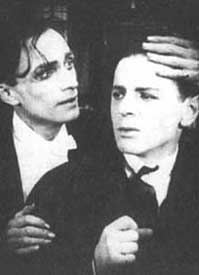 Veidt plays Korner, a gay violinist. He has been collecting news clippings on homosexual suicides triggered by Paragraph 175, a German law criminalizing homosexuality, & which the nazis made good use of a couple decades later. Veidt plays Korner, a gay violinist. He has been collecting news clippings on homosexual suicides triggered by Paragraph 175, a German law criminalizing homosexuality, & which the nazis made good use of a couple decades later.
He ponders the names of great men in history who were gay, & builds his own self-esteem sufficiently to meet with & begin a relationship with a very young man, Kurt (Fritz Schulz), who is devoted to classical music & could benefit by a mentor.
Blackmailer Franz (Reinhold Schunzel) on observing the relationship between Kurt & the older Korner begins to insinuate himself into Korner's life. Franz is himself gay but nevertheless feels no qualms threatening other gay men to obtain cash, the notorious Paragraph 175 making it very easy to threaten homosexuals with imprisonment or in Korner's case, at the very least, the loss of his career as a concert violinist.
But Korner balks & decides to take his chances. Sundry complexities & scenarios mount up, always with the "lesson" of tolerance in mind. Franz eventually turns Korner in & he is prosecuted as a criminal.
He is sentenced to one week detention, instead of the three years in prison the law allows, for the court was not convinced Korner was anything but a good man rendered a criminal by a dubious law. Despite the comparative tap on the wrist, he's nevertheless shunned thereafter by society & his concert tour is cancelled. His little collection of newspaper notices of gay men's suicides begins to make more & more sense to him.
Unfortunately the persecuted characters aren't all that sympathetic & Korner is a little creepy with his preference for very young men, & his use of a mentoring authority to obtain what amounts to boy lovers, rather than men close to his own generation. For an "enlightenment" film this wasn't all that enlightened, & comes dangerously close to a plea for tolerance of pederasty rather than homosexuality between consenting adults.
Still, for such a relic on the tedious side, the film's assertion that "only ignorance or bigotry" would disapprove of homosexuality was bold for its day. Enough so to get it banned & nearly lost even to history.
Missing scenes are bridged by film stills. The text cards for this silent film are excessive & didactic, which was the nature of the "Enlightenment Films" of the time. One long tedious scene is literally an instructional lecture which the main characters attend & listen to intently.
So it was nice to see even in this fragmented form, but it's more for its historical value than its strength as drama, good though Veidt inevitably is.
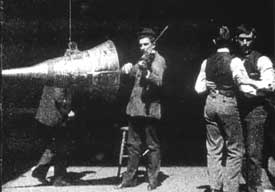 Although only a few overtly gay films are known to survive from the silent era, the world-wide history of homosexuality in the cinema does begin with the silent era, & is quite extensive on one or another level. Although only a few overtly gay films are known to survive from the silent era, the world-wide history of homosexuality in the cinema does begin with the silent era, & is quite extensive on one or another level.
That would include the level of who the stars really were, beginning with gay or bisexual actors like the still unforgotten Ramon Navarro or Rudolph Valentino. Forgotten silent film players include Ray Bourbon who was a stunt double & drag performer in films of the early 1920s, & who afterward performed as a drag comedian in a travelling gay acting troupe.
A specifically gay film history begins at the deepest roots of motion pictures, at the Thomas Edison Black Maria studio in 1895. William Dickson's under-two-minute experimental sound film was only known as a silent film until its sound cylinder was modernly rediscovered, & the film fully restored in 2001.
It was the first film ever made with live sound recording, & evidently the first film ever made for use on Kinetophone, which was a Kinetoscope with cylinder phonograph attached. It is the only surviving Kinetophone film.
It also has the distinction of being the oldest known hence first gay film. It shows a man (Dickson himself) playing violin in front of a recording horn, while two men dance together in a relaxed close embrace with no hint of comic intent. Even Dickson's song choice is suggestive: "Song of the Cabin Boy."
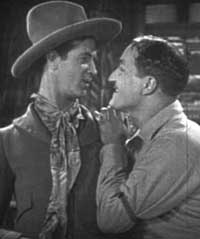 In A Wanderer in the West (1927) the store clerk Clarence tries to seduce a cowboy. In A Wanderer in the West (1927) the store clerk Clarence tries to seduce a cowboy.
In Laurel & Hardy's The Soilers (1923) set in the Alaska gold rush, we see a prissy cowboy mincing about the stage (see also Laurel & Hardy's Gay Cinema for their broader cultural contributions).
The sissy was in general a stock character of early film comedies, but he becomes the central character of Algie the Miner (1912). An overtly gay sissy, Algernon Allmore (Billy Quirk), goes off adventuring in the wild west.
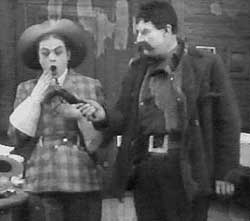 Algie gets to kiss gun-totin' western cowboys, becomes bonded with a butch gunslinger, & just generally lives a fullfilling life in the west. Algie gets to kiss gun-totin' western cowboys, becomes bonded with a butch gunslinger, & just generally lives a fullfilling life in the west.
Jokes include Algie fainting into the protective arms of his tough buddy Jim, & the two of them playing a game of innuendo about the size of their guns, Jim taking Algie's tiny darringer & giving him a big six-gun.
Sweetest of all, Algie comforts & embraces his pal lovingly when the man is reduced to tears & terror by the delirium tremons, Algie striving to help Jim overcome his drinking problem, & even saving Jim from a beating when other tough-guys find him drunk & unarmed.
One can't help but suspect that this being a film directed & produced by a woman, Alice Guy, had something to do with its surprising degree of liberal acceptance of homosexuality, the flaming stereotype of Algie's character notwithstanding.
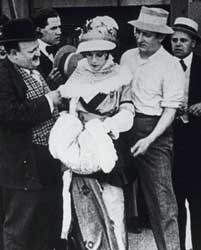 Charlie Chaplin in The Masquerader (1914) gets all decked out as a surprisingly pretty girl & then fails to evade the embraces of interested suitors. Charlie Chaplin in The Masquerader (1914) gets all decked out as a surprisingly pretty girl & then fails to evade the embraces of interested suitors.
Although a text card notes that "a fairy floated into the studio" the actors & crew are convinced Senorita Chapelino's a gal & give her lots of manly attention. Groping, chasing, & all round competition for the seniorita's affections ensue.
In one of the earliest examples of extreme hatred for homosexuals on the screen, when Charlie's deception is revealed, a fistfight ensues, & the men who'd courted him allow him to drown in a well. Sad to realize Charlie wrote it himself.
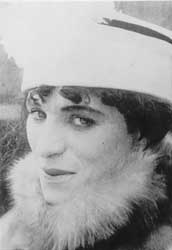 He again does without his famous mustache & cross-dresses in order to seduce two men in A Woman (1915). He looks pretty good in drag & flirts outrageously with the bald guy & the mustachioed lothario. He again does without his famous mustache & cross-dresses in order to seduce two men in A Woman (1915). He looks pretty good in drag & flirts outrageously with the bald guy & the mustachioed lothario.
The women of the house are in on the joke & watch as Charlie gets the men competing for "her" attentions & even tricks them into kissing each other.
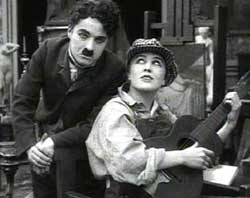 Chaplin further used gender-bender humor in Behind the Screen (1916) in which he courts a young woman (Edna Purviance) who is passing as a young man. Chaplin further used gender-bender humor in Behind the Screen (1916) in which he courts a young woman (Edna Purviance) who is passing as a young man.
Edna visits a movie set seeking to become an actress but is turned away. Charlie is a hardworking though awfully clumsy stage hand. Most of the film is slapstick with Chaplin & fat comic Eric Campbell at the center of the pratfalls. Alot of it is extremely funny, one of Charlie's best scripts for gags.
Edna later turns up to get any job at all associated with the theater, having disguised herself as a young man. Charlie is slightly flirtations with the "boy" even before he discovers the truth, but when he figures it out he protect's Edna's identity even while courting & kissing "him."
When Campbell makes abusive fun of Charlie's affair with the effeminate lad, Chaplin defends his "boyfriend's" dignity. It all ends with a pie fight & complete distruction of the set.
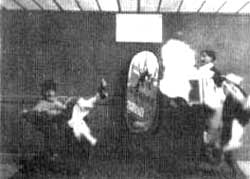 The Old Maid Having Her Picture Taken (1901) starred Gilbert Saroni who specialized in "the ugly old maid" character of Vaudeville skits. When "she" comes to the portrait studio to have a picture taken, her ugliness causes the mirror to crack. When she poses for the camera, it explodes. The Old Maid Having Her Picture Taken (1901) starred Gilbert Saroni who specialized in "the ugly old maid" character of Vaudeville skits. When "she" comes to the portrait studio to have a picture taken, her ugliness causes the mirror to crack. When she poses for the camera, it explodes.
In the immediate sequel, The Old Maid in the Drawing Room (1901) the old maid just mugs to maximize ugliness in close-ups.
Though these were separate kinetoscope films, the Edison company advertised them to their clients (i.e., to kinetoscope parlor managers) as a pair to be shown together. The second film gives a better impression as to how such a mug could cause a camera or a mirror to break.
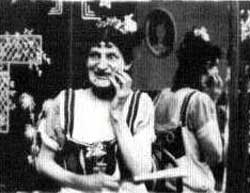 Saroni's first two short-short films were directed by America's first great director, Edwin S. Porter, who directed the first western, The Great Train Robbery (1903). Saroni did his crossdressing shtick in a few other kinetoscope films whose directors are unknown. Saroni's first two short-short films were directed by America's first great director, Edwin S. Porter, who directed the first western, The Great Train Robbery (1903). Saroni did his crossdressing shtick in a few other kinetoscope films whose directors are unknown.
One of these, Meet Me at the Fountain (1904), is a spoof of the Biograph film Personal (1904) which Porter had refilmed for the Edison company as How the French Nobelman got a Wife through the New York Herald Personal Columns (1904).
The original tale was a straight-out boy-meets-too-many-girls comedy with big chase scene, but in the spoof, when Count Hardup first lays eyes upon his date in old maid drag, he flees in terror, only to be pursued. This may also be the first gay kiss of cinema.
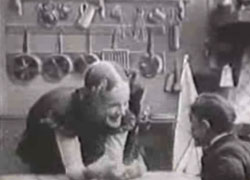 There are undoubtedly many more cross-dressing comedies or farces in silent cinema than have yet been catalogued, more on the order of: Don't Tell Everything (1927) in which a young man (Spec O'Donnell) poses as a maid & adheres to the role even in private; What Happened to the Inquisitive Janitor (Par le trou de serrure, 1901) in which a peeping tom encounters a crossdresser. There are undoubtedly many more cross-dressing comedies or farces in silent cinema than have yet been catalogued, more on the order of: Don't Tell Everything (1927) in which a young man (Spec O'Donnell) poses as a maid & adheres to the role even in private; What Happened to the Inquisitive Janitor (Par le trou de serrure, 1901) in which a peeping tom encounters a crossdresser.
And in a three-minute short with overtly gay qualities, Tom Thumb in Love (Tom Pouce suite une femme, 1910), about a midget courting a tall balding tranvestite.
In this latter, "she" blushingly kicks the little guy over with a foot, but accepts a flower, poking him a couple times in the face with "her" enormous shoed foot. They flirt with one another in the most charming manner until finally the transvestite very ungenerously tosses the little suitor out the window rather than consumating the affair.
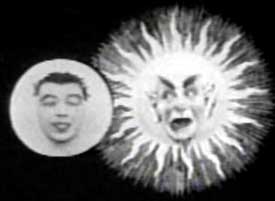 Georges Melies was a pioneer of special FX filmmaking in Paris. He adored novelty & jest & took an opportunity to insert a bit of gay romance in The Eclipse: The Courtship of the Sun & Moon (L'Eclipse du Soleil en plein e lune, 1907).
Georges Melies was a pioneer of special FX filmmaking in Paris. He adored novelty & jest & took an opportunity to insert a bit of gay romance in The Eclipse: The Courtship of the Sun & Moon (L'Eclipse du Soleil en plein e lune, 1907).
Approaching ten minutes length, the film introduces us to a medieval room where attendees seat themselves to listen to an astronomer's lecture.
He proceeds to explain the nature & meaning of eclipses. They then repair to the attic, where a large telescope is prepared to watch the eclipse of the sun.
A shockingly swishy, distinctly male Moon makes goo-goo eyes at the Sun. The older lascivious sun moves behind the Moon. The Moon looks delighted to be done in the rear. Sun & Moon then part & go their own ways, as it was just one of those quickie sort of things.
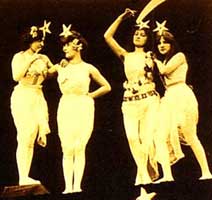 There follows a chapter called "Wandering Stars" as sundry heavenly bodies pass by -- comets, planets, moons, stars -- each with fairy or divinity riding thereon. There follows a chapter called "Wandering Stars" as sundry heavenly bodies pass by -- comets, planets, moons, stars -- each with fairy or divinity riding thereon.
The next chapter "Unexpected Bath" animates a rain of falling stars that turn into floating women with stars for tiaras.
It might have gone unnoticed, if not for the homosexual nature of the eclipse itself, that these star-tiar-ed fairy-goddesses are mostly seen in close pairs, arm in arm.
This gets the astronomer so excited that he moves to the window & falls out of the attic observatory, landing head-first in a rain barrel.
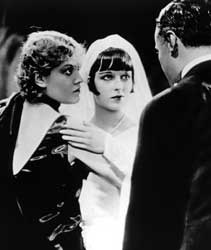 It's an imaginitive little film throughout, but it's the gay romance of the Sun & Moon that makes it uniquely a winner. It's an imaginitive little film throughout, but it's the gay romance of the Sun & Moon that makes it uniquely a winner.
G. W. Pabst's Diary of a Lost Girl (Das Tagebuch einer Verlorene, 1929) incorporates gay imagery, including reform school girls in bed together, & harlots dancing with one another, besides having Louise Brooks experience a "pile up" of girls.
More powerful is Pabst's Pandora's Box (Die Buchse der Pandora, 1929) includes the lesbian Countess Anna Geschwitz who glowers menacingly at the men who fascinate & are fascinated by the sexually daring Lulu (Louise Brooks), who destroys her own life & the lives of her lovers just by being so darned pretty & available.
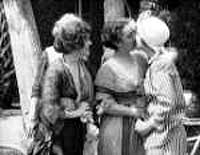 Pabst's hysterical warning against women being sexual is often said to embody, in the Countess, the first presentation of an overt lesbian character in cinema. Pabst's hysterical warning against women being sexual is often said to embody, in the Countess, the first presentation of an overt lesbian character in cinema.
But if short films are included, Pandora's Box is long predated by A Florida Enchantment (1914).
This features a lonesome woman who finds some old pills which like Alice through the Looking-glass she risks trying, thus awakening her inner lesbian. She butches up & heads out cruisin' for love.
Also predating Pandora's Box is The Four Horsemen of the Apocalypse (1921) which includes incidental gay imagery, including a butch-femme couple in the audience for a drag show at a Paris club; & Twelfth Night (1910) from Shakespeare, in which Olivia falls in love with Viola.
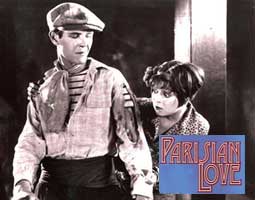 In Parisian Love (1925), Clara Bow as Marie behaves increasingly eccentric in her frustrated attempts to attract Armand away from his boyfriend Marcel. In Parisian Love (1925), Clara Bow as Marie behaves increasingly eccentric in her frustrated attempts to attract Armand away from his boyfriend Marcel.
More seriously, in Carl Dryer's Michael (Mikael, 1924), a young man involved with an older man betrays his sugar daddy by getting involved with a woman.
Based on a novel by Herman Bang, it had earlier been filmed as The Wings (Vingarne, 1916), about a bisexual artist's model who has two people vying for his attentions, the gay artist, & a Countess.
The lurid Sex in Chains (1928) is a German silent, undoubtedly the first film to look at homosexuality behind bars with surprising candor.
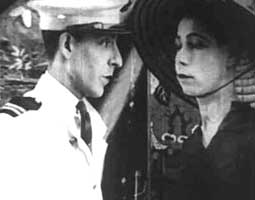 Le menage moderne du Madame Butterfly (1920), by early erotic filmmaker Bernard Natan, has as its highlight homosexual oral sex. Le menage moderne du Madame Butterfly (1920), by early erotic filmmaker Bernard Natan, has as its highlight homosexual oral sex.
The transitional Lot in Sodom (1933) is partly a talkie but mostly in the mode of a silent film, especially for the startling opening sequence which depicts the erotic temple rituals of the Sodomites.
Sodomites also make an appearance among the doomed in Hell, in Inferno (1911), based on Dante's Divine Comedy.
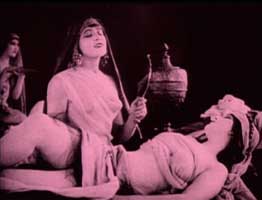 And in D. W. Griffith's Intolerance (1919) we encounter an ancient world scene with temple "virgins" lounging half-naked & making googly eyes at one another's gorgeous bods. And in D. W. Griffith's Intolerance (1919) we encounter an ancient world scene with temple "virgins" lounging half-naked & making googly eyes at one another's gorgeous bods.
Rudolph Valentino was married at different times to two lesbian actresses, probably "lavender marriages" as Valentino needed a so-called "beard" to quiet rumors about his own sexuality.
The first of these actresses was Jean Acker, the latter Natacha Rambova who designed the costumes after Beardley for the film version of Oscar Wilde's Salome (1923).
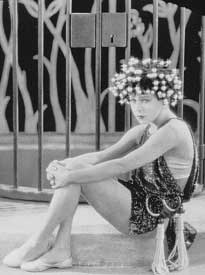 Alla Nazimova was the star, producer, & scenarist adapting Wilde. The nominal director was her husband, flamboyant homosexual Charles Bryant. But it's generally acknowledged that Nazimova was the actual director & it's her film bottom to top. Alla Nazimova was the star, producer, & scenarist adapting Wilde. The nominal director was her husband, flamboyant homosexual Charles Bryant. But it's generally acknowledged that Nazimova was the actual director & it's her film bottom to top.
Nazimova had had affairs with both of Valentino's wives. The entire cast for Salome constituted the Hollywood gay community of the day, including drag queens from the local bar scene.
The casting induced one reporter to ask Nazimova why Valentino wasn't in her film, a not at all veiled allusion to what Hollywood knew or suspected. Nazimova reputedly quipped, "He would have been in it, but had prior film commitments."
Salome captures the style & tone of the Yellow Decade which gave rise to Wilde & his play. The costliness of the production meant it would lose money even if the public had been more interested. It really is a pretty film whether or not one is tickled to realize every character that flits across the screen in his or her art nouveau drag is a faggot or a dyke.
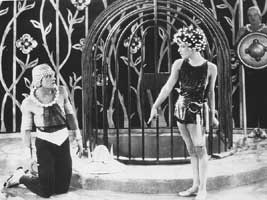 Wilde's play was widely regarded as "depraved," about the biblical Salome who danced her Dance of the Seven Veils for the head of John the Baptist. Merely kitschy by today's standard, it's hard to imagine what the fuss was about.
Wilde's play was widely regarded as "depraved," about the biblical Salome who danced her Dance of the Seven Veils for the head of John the Baptist. Merely kitschy by today's standard, it's hard to imagine what the fuss was about.
Dearest Oscar did not live to see it produced on the stage, as his own persecution & prosecution for homosexuality resulted in an early death, for he never recovered from jailhouse conditions.
The silent film made of his play over two decades later should've been better received in the environment of the "Roaring 'Twenties" but it was not.
The play's reputation was still for depravity, & the notorious bisexual & homosexual troupe involved with its production was hardly good advertising in a closety age when too great an interest might result in the audience itself being persecuted as a little too interested in gay art.
One thing assured from Salome today is a full measure of entertainment, even if it is a little goofy. It remains gloriously over the top.
copyright © by Paghat the Ratgirl
|

 Veidt plays Korner, a gay violinist. He has been collecting news clippings on homosexual suicides triggered by Paragraph 175, a German law criminalizing homosexuality, & which the nazis made good use of a couple decades later.
Veidt plays Korner, a gay violinist. He has been collecting news clippings on homosexual suicides triggered by Paragraph 175, a German law criminalizing homosexuality, & which the nazis made good use of a couple decades later.

 Algie gets to kiss gun-totin' western cowboys, becomes bonded with a butch gunslinger, & just generally lives a fullfilling life in the west.
Algie gets to kiss gun-totin' western cowboys, becomes bonded with a butch gunslinger, & just generally lives a fullfilling life in the west.
 He again does without his famous mustache & cross-dresses in order to seduce two men in A Woman (1915). He looks pretty good in drag & flirts outrageously with the bald guy & the mustachioed lothario.
He again does without his famous mustache & cross-dresses in order to seduce two men in A Woman (1915). He looks pretty good in drag & flirts outrageously with the bald guy & the mustachioed lothario. Chaplin further used gender-bender humor in Behind the Screen (1916) in which he courts a young woman (Edna Purviance) who is passing as a young man.
Chaplin further used gender-bender humor in Behind the Screen (1916) in which he courts a young woman (Edna Purviance) who is passing as a young man.
 Saroni's first two short-short films were directed by America's first great director, Edwin S. Porter, who directed the first western, The Great Train Robbery (1903). Saroni did his crossdressing shtick in a few other kinetoscope films whose directors are unknown.
Saroni's first two short-short films were directed by America's first great director, Edwin S. Porter, who directed the first western, The Great Train Robbery (1903). Saroni did his crossdressing shtick in a few other kinetoscope films whose directors are unknown. There are undoubtedly many more cross-dressing comedies or farces in silent cinema than have yet been catalogued, more on the order of: Don't Tell Everything (1927) in which a young man (Spec O'Donnell) poses as a maid & adheres to the role even in private;
There are undoubtedly many more cross-dressing comedies or farces in silent cinema than have yet been catalogued, more on the order of: Don't Tell Everything (1927) in which a young man (Spec O'Donnell) poses as a maid & adheres to the role even in private; 
 There follows a chapter called "Wandering Stars" as sundry heavenly bodies pass by -- comets, planets, moons, stars -- each with fairy or divinity riding thereon.
There follows a chapter called "Wandering Stars" as sundry heavenly bodies pass by -- comets, planets, moons, stars -- each with fairy or divinity riding thereon. It's an imaginitive little film throughout, but it's the gay romance of the Sun & Moon that makes it uniquely a winner.
It's an imaginitive little film throughout, but it's the gay romance of the Sun & Moon that makes it uniquely a winner. Pabst's hysterical warning against women being sexual is often said to embody, in the Countess, the first presentation of an overt lesbian character in cinema.
Pabst's hysterical warning against women being sexual is often said to embody, in the Countess, the first presentation of an overt lesbian character in cinema. In Parisian Love (1925), Clara Bow as Marie behaves increasingly eccentric in her frustrated attempts to attract Armand away from his boyfriend Marcel.
In Parisian Love (1925), Clara Bow as Marie behaves increasingly eccentric in her frustrated attempts to attract Armand away from his boyfriend Marcel. Le menage moderne du Madame Butterfly (1920), by early erotic filmmaker Bernard Natan, has as its highlight homosexual oral sex.
Le menage moderne du Madame Butterfly (1920), by early erotic filmmaker Bernard Natan, has as its highlight homosexual oral sex. And in D. W. Griffith's
And in D. W. Griffith's  Alla Nazimova was the star, producer, & scenarist adapting Wilde. The nominal director was her husband, flamboyant homosexual Charles Bryant. But it's generally acknowledged that Nazimova was the actual director & it's her film bottom to top.
Alla Nazimova was the star, producer, & scenarist adapting Wilde. The nominal director was her husband, flamboyant homosexual Charles Bryant. But it's generally acknowledged that Nazimova was the actual director & it's her film bottom to top. Wilde's play was widely regarded as "depraved," about the biblical Salome who danced her Dance of the Seven Veils for the head of John the Baptist. Merely kitschy by today's standard, it's hard to imagine what the fuss was about.
Wilde's play was widely regarded as "depraved," about the biblical Salome who danced her Dance of the Seven Veils for the head of John the Baptist. Merely kitschy by today's standard, it's hard to imagine what the fuss was about.